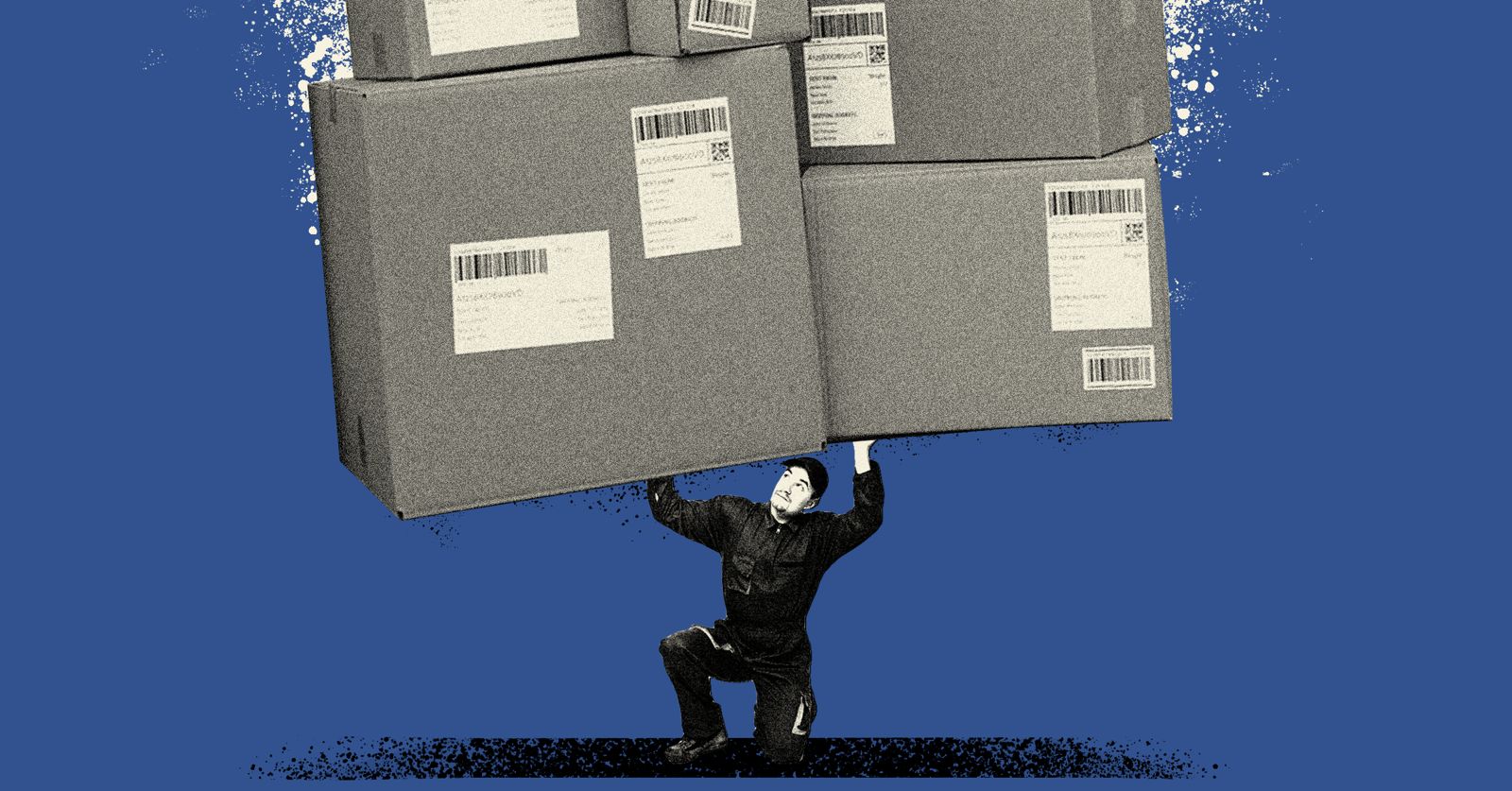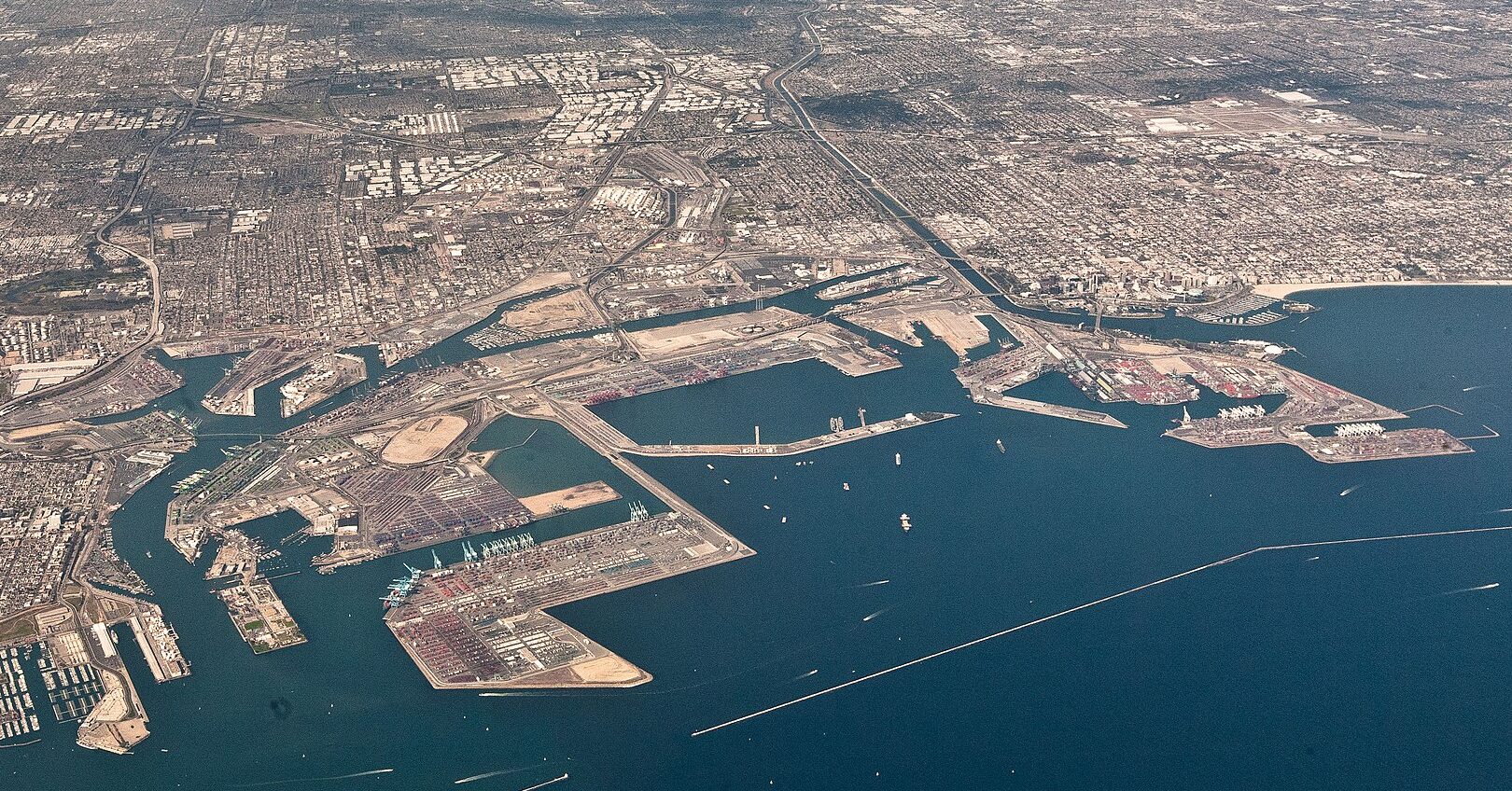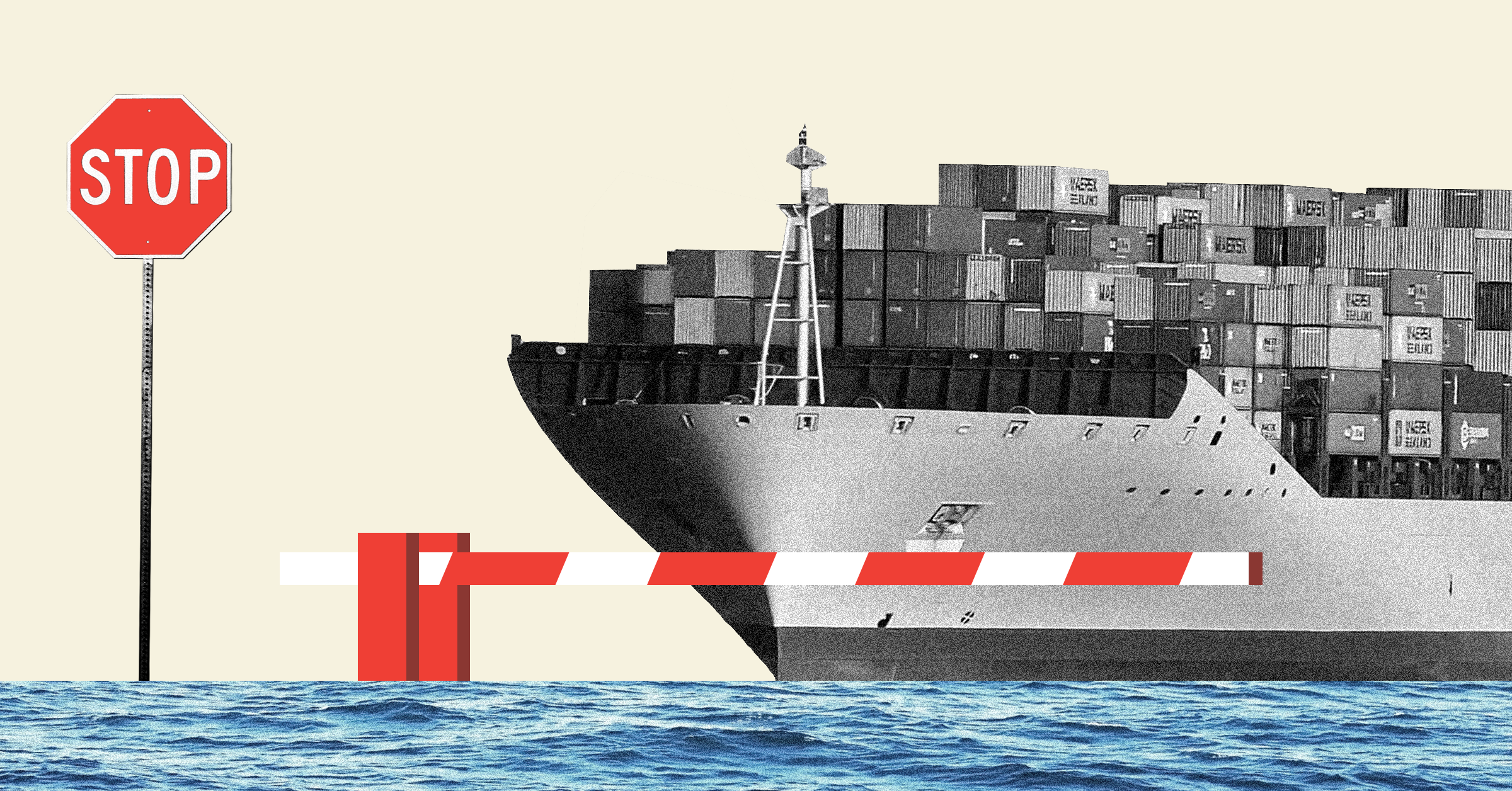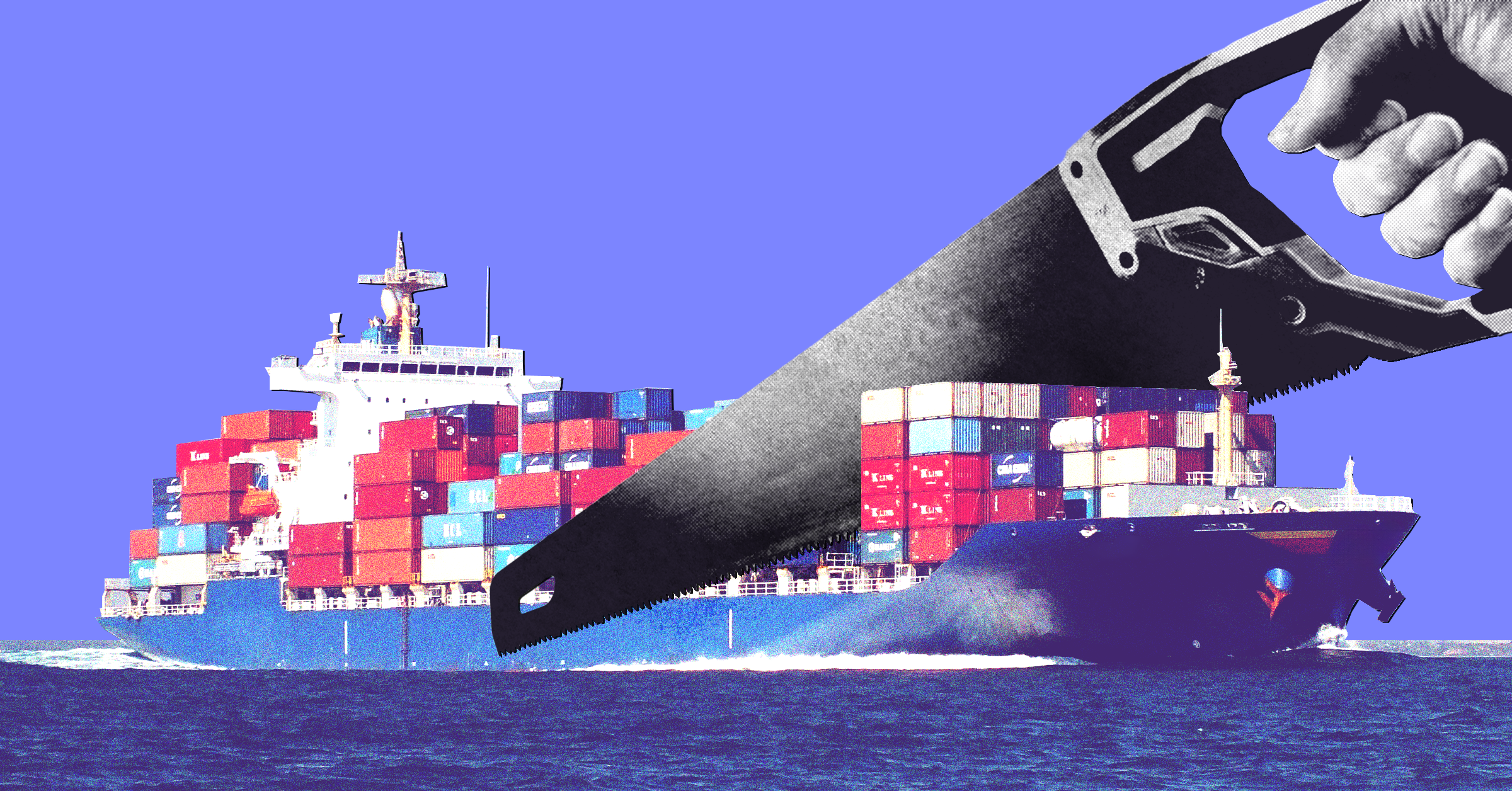In Labor Notes Kim Moody argues that companies are shifting away from the “lean” model of organizing production and logistics, where all systems operate with no room for error. Somewhere between “just in time” and the older “just in case” models, companies are looking for greater redundancy in their production and distribution networks. To oversee these networks and the workers within them, they rely on increasingly sophisticated algorithms not only to calculate exactly which tasks should be performed in which order, but to push the pace up to and beyond workers’ breaking point. Call it Amazonification.
To maximize workers’ leverage, we need to understand the pressure points in the new system. To this end, Andrej Markovčič interviewed Labor Notes founder Kim Moody.
Moving Away From Just in Time
Andrej Markovčič: During the Covid pandemic suddenly supply chains — and their disruption — were a very public topic of conversation. You argue that management is now shifting away from just-in-time strategies and other traditional features of lean production — strategies that have dominated the way global business operates for the last half century. This has big implications for worker power. Can you explain first what lean production is and how it was a change in business operations?
Kim Moody: Lean production as a whole was introduced in the U.S. in the 1980s, then Europe and elsewhere as time went on. There are three important elements.
First is just in time delivery. The old way of doing things in manufacturing we now sometimes call “just in case.” Companies carried large inventories of parts and supplies, so they wouldn’t run out of anything. You can look at the figures; the ratio of parts to production was quite high back then. But by the 1970s, facing a crisis of profitability, it became apparent to manufacturers they had to change.
So they looked to Japan. To the Toyota model in particular. Just in time means specifically that parts are delivered to the plant only as needed. That means inventories are very low. You can’t have a zero inventory, but they’re very low. Consequently within the production system itself, just in time continues all along the way. Along the assembly line and in the various departments where goods are produced, and in the supplier companies as well. In each case the parts and the supplies are only delivered just as needed. Which means deliveries to the factory have to be timed pretty accurately, otherwise the whole system begins to break down. That’s just in time.
The second aspect is the intensification of labor. In official lean production language that’s “continuous improvement” or “kaizen.” In Labor Notes language from Jane Slaughter and Mike Parker, it’s “management by stress.” It only differs from Taylorism in the way the speedup is done. Under traditional Taylorism, management observed workers and decided how to get them to work more efficiently. In the Toyota system, teams of workers are encouraged to give their own knowledge of how production really works. Management takes that and uses it against the workers. In most places teams haven’t really functioned for a long time, but lean managers still use the concept that productivity should continue to grow continuously over a long period of time. They are always trying to squeeze more motions per minute out of the workforce, forever.
The third element is outsourcing, of every possible thing that can be outsourced. In the eighties and nineties this would be both domestically and internationally. Now think about that. That creates a longer extended system of supply chains. Because now your Michigan-based auto plant is getting parts from Kentucky or Tennessee up and down I-75 . Or coming from abroad, Japan, China. What that means, when you put that together with just in time: the whole supply system, the whole logistical system has to be in pretty good shape, has to be working normally. Yes, there will be disruptions, a tsunami here, or a flood there, or a strike. But, generally speaking, the system has to function tightly. Well, beginning with the Great Recession, 2008 to 2010, things stopped working so well.
Andrej: This is something that is missed in the basic narrative we have about the pandemic period. The supply chain crisis was very acute during and after lockdowns, but you point out that just-in-time had already been falling apart in many ways for quite some time.
Kim: Yes, particularly manufacturing productivity collapsed after 2010. Also in trucking and warehousing, which every aspect of the making and moving of goods in the United States depends on. If you look at the Purchasing Managers’ Index figures for delivery times, they begin to rise around 2016. Obviously the pandemic introduced a level of disruption that was much larger, but that was already in the making. Companies were still using lean techniques, but they weren’t boosting productivity anymore.
The End of Lean Production
Andrej: Why is it such a crisis that they were not able to squeeze more productivity gains out of these production methods over the previous decade?
Kim: Well, increased productivity is how you get increased profits. If your productivity isn’t growing, your company isn’t growing, your profits aren’t growing. People are not going to buy your stock. So you have to do something about that.
The first thing that companies began to do around the pandemic was to get rid of just in time, and to go to a higher level of inventory. Again, if you look at the figures, inventory is not nearly as high as it was during the so-called golden age of industry from the end of World War II to the 1970s. But it’s higher than it was before, and it’s been going up pretty regularly.
But companies don’t like this, keeping inventory is expensive. Inventory has to be stored somewhere. That means additional warehouse space, potentially climate-controlled. It requires security and maintenance to keep it ready for sale. Any surplus inventory a company holds represents money it can’t use for something else. It’s dead weight. Imagine two companies, one that sells a product built with parts that sit in inventory for 30 days, another that builds the same product with parts that show up the day of manufacturing. The first company has 30 extra days of inventory expenses cutting into their profits. That’s why they like just-in-time.
When I say the end of lean production, I don’t mean that companies have stopped trying to push their workers to do more for less, or that they’ve stopped using the lean production measurement techniques that they’ve used in the past. A lot of them still use that. And then there are other industries where lean production came later. Hospitals, hotels are still using the lean production methods where maybe productivity didn’t collapse as much as it did in manufacturing, mainly because it was newer. But again, there’s a limit to how much you can do just by pushing people.
So industry reached that point in the last few years. And so companies are now abandoning just-in-time, and whether they still use some of the other techniques, they don’t seem to be working. I haven’t looked at the productivity growth figures for maybe a month or so, but, as far as I know, they’re still all so low as to be almost zero. Which is a catastrophe for the companies’ profitability. Some companies made a lot of money during lockdowns due to shortages, but they still haven’t fixed the long-term productivity problem. In the years leading up to the pandemic, profits were very weak in manufacturing and transportation. So that’s what I mean by the end of lean production. It’s no longer doing what it’s supposed to.
Another problem for productivity is that technology is not paying off as hoped. Auto plants looked at investments in things like robots. And what they found was that they weren’t working. So companies have stopped investing at the same rate.
The Next Production Model
Andrej: So if productivity is stagnant, the gains from lean production methods aren’t what they used to be, and robots aren’t what was promised, what comes next?
Kim: We don’t know exactly what is going to come next. But the main thing so far is the attempt to intensify labor through the use of digital technology. Companies are increasingly turning to algorithms to direct and measure labor. That’s where I come to Amazon as the model for the future. They’re the pioneers.
When Amazon started back in the late nineties and early two thousands, they were using lean production techniques. But as they evolved, because of the nature of the business — that is, bringing in products, moving them around, and selling them — inventory became a major problem. If you’re handling millions of products every day in your system and they’re going to thousands of different locations, you’re going to have to have not only infrastructure to deal with that but a method of keeping things moving. It can’t be just in time, because you’re dealing with just way too many things and you’re going to too many different places, not like a factory where maybe you have a thousand suppliers but they all come to one place. First you had your fulfillment centers, then you needed a sortation center. After that, you need delivery stations because you’ve got so many customers in a big metro area and they want their package the next day. You have to have a facility that’s closer to the customer itself.
Amazon can combine this with digitalization in a way that manufacturing can’t because a lot of what they need to do is directing products. And so their algorithms not only tell the workers in their facilities what to do and when and how fast, but they also guide the movement of a product from when it comes into a fulfillment center to when it goes out between different Amazon facilities to the trucks that move it all the way to the customer. The old way that goods tended to move was called the hub and spoke. They’ve gone beyond that now. There is no single hub.
Andrej: Here we get to what stood out to me as one of the key interventions in your article. As you just described, Amazon has this dense network of facilities, orchestrated by a very sophisticated physical and digital infrastructure. It has given them this aura of invulnerability. They’re so ahead of the game they can’t be touched. You cite some people who imbibe this idea. I’ll admit my first thought was that obviously more distribution centers means more redundancy, which would seem to cut down on workers’ power — the work can just be sent elsewhere. But you point out it’s more complicated than that. They have more nodes, but they’re not really developing excess capacity. Their business model requires them to put it to maximum use. So rerouting may be easier than when there’s only one facility, but it’s not trivial. Disruption is still possible.
Kim: They do talk about their redundancy to some extent, and they can move from one facility to another. But it depends on the other location not operating at full capacity. There has to be loose capacity and the whole point of the Amazon system is to eliminate as much of that as possible. That’s what they mean by what they call “optimum inventory velocity.” They have to keep things moving all the time. That’s the whole point. Of course they do have inventory, but as much as possible they try to eliminate or reduce the costs of inventory.
That is how other businesses understand this model. Target is doing the same thing. They’re using the same idea of having an increasingly dense network that moves things constantly at a maximum speed. The idea is not to keep your inventory any longer than you have to, and that does require a dense logistics network. So I use the term Amazonification. Businesses are increasing their inventory, as I argued earlier, but they’re also trying to figure out how not to increase it too much. It costs money to hold inventory.
The consequence of other businesses adopting this model is the growth of warehouse and trucking firms. When I started looking at this stuff I was not quite shocked, but surprised, to see the rapid growth in the number of warehouses and trucking firms. This indicates to me that the whole logistics model is moving in the Amazon direction. Of course it won’t be an exact copy but it has some similarities. Not only in the number of facilities that are required for it but in the use of digital tools to guide truck routes and time people.
Here artificial intelligence, or algorithms more generally, have a kind of value that they don’t quite have in manufacturing. Even advanced manufacturing robots have a limited range of motion. But if AI is directing logistics workers in their delivery routes or Amazon workers in the distribution center, it’s ultimately the human worker executing the motions. Unlike a robot, the computer is not moving anything.
There are people who argue that Amazon has enough redundancy or enough control through algorithms to make a strike in one facility not have a big impact. There is some truth in this, but there’s a limit. Because to the extent that Amazon facilities are operating close to the maximum, there’s a limit to the redundancy.
If in an Amazon warehouse the pickers stop picking, the algorithm can tell them what to do. But they can tell the algorithm to go screw itself. That may be too small to have a major impact, but if we begin to think of this collectively, not just as one picker or even one small group of pickers, also packers and the people who load and unload the trucks, we can see ways in which not just strikes but even a slowdown or work to rule can have a big impact.
Worker Organizing in the New System
Andrej: This factor of excess capacity seems to emphasize the importance of organizing drives building connections across hubs in order to limit Amazon’s ability to respond. You cite a figure that, by their own calculations, a 1% increase in inventory costs across Amazon’s system can wipe out their profits. They present this as a business risk.
Kim: Right. I think, looking at work Amazonians United have done, like organizing simultaneous walkouts at Amazon delivery stations, they clearly have discovered some of these points. They do talk about the need to coordinate across facilities. They realize this problem, but also this opportunity. I also think, by the way, with Amazon, where the movement of things is so important, you don’t need to bring down a whole region, a whole metro area. If you bring down a few facilities, you’re already costing them hundreds of millions.
Andrej: You’ve mentioned Walmart and Target as trying to emulate Amazon. They have the kind of scale that they can at least consider it. What does the evolution you’re describing mean for companies that don’t have the capacity or footprint within their industry to adopt these practices? What do these changes mean for labor struggles outside Amazon or similar companies, with inventories creeping up?
Kim: In a sense, it actually means workers have somewhat more leverage. Let’s say it’s GM, or Ford, Toyota, Mercedes. They aren’t going to get income coming as fast as Amazon does so they have more of an inventory problem.
There are always these levers. And they’re not always the same one for each company. But again, thinking of this in terms of inventory: if you had a strike at a place that is operating with a higher level of inventory, that’s going to be a burden for the employer during the strike. That idle inventory is a cost they can’t ignore.
What’s different from the past, and I’m drawing on other people’s work, is that there are more and more of these points of connection that need to be made by labor. Human labor. The algorithms can’t cross these points of connections without human involvement. Computers cannot unload a truck. I don’t pretend to know where all these connections are, it would take a huge team of analysts looking at all this stuff. But I think workers are beginning to understand that. Just like in 1936, the UAW organizers knew very well what kind of plant could close down the whole GM system as opposed to just part of the system. The Chevy 4 sit-in wasn’t the first one. There had been several of them before, and they didn’t have the same impact. So the organizers found the sweet spot, and the sit-down shut down GM.
I’d like to think that union research departments would do this. I frankly doubt it. I hope they do. But I think workers will begin to think about this more and more, particularly once we get to the point where Amazon workers become more organized and the actions that people take become visible to the public. We need to find out where in our workplace, or outside the workplace, are the chokepoints? Where are the weak points? And we learn collectively, not as individuals, but collectively how to do that.
Demystifying the New System
Andrej: Right. So what it comes down to is that as long as there are humans required in a given process, there is opportunity to stop it.
Kim: We have to demystify. I did a piece in Historical Materialism a while back, which is a precursor to this latest one, where I try to demystify technology and automation by talking about its material basis. The material of how the whole system of movement and production works. What are the points of connection? Undersea cables, for example. There are 45 cables along the ocean floors which carry nearly all data between the US and the rest of the world. These are maintained and operated by human labor.
Andrej: I was recently reading that they’re running out of boats and technicians to repair them.
Kim: Yes. Then there’s the whole question of data centers. This is in the Historical Materialism article. Most people are not aware of what these things are, but they’re extremely important. These are warehouse-sized facilities filled with cables and servers which require regular maintenance. A 2019 report from the Uptime Institute estimated that there is a global data center workforce of about 2 million people. About half of those jobs are in the US. We tend to associate the ‘cloud’ with highly credentialed, high-tech professionals. But the same researchers reported that most data center jobs require little specialized training. In other words, a largely non-union, proletarian workforce. This seemingly immaterial industry has very material foundations. They are so high tech and so primitive at the same time.
I just read a study of port automation relevant to the current situation of the ILA that shows even in “fully automated” ports, of which there are very few, there are points where human intervention is still needed. Notably in “lashing,” i.e., connecting and unconnecting containers with “twistlocks” to load and unload ships. While ship-to-shore cranes can be operated remotely, they are still operated by human beings. And, of course, the trucks entering and leaving the port are still driven by actual workers.
So, human points of connection are still essential to the movement of goods even in the most technologically advanced ports.




